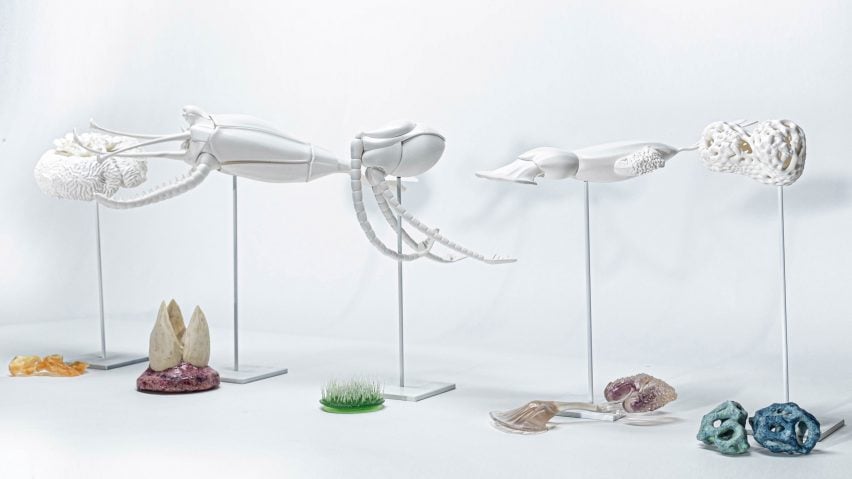
University of Applied Arts Vienna spotlights ten student design projects
Dezeen School Shows: a garment that takes cues from the lived experience of the queer community and a toy designed by humans and AI are featured in Dezeen's latest school show by students from the University of Applied Arts Vienna.
Also included is a series of objects that propose an earth with alternative organisms and a project where the designer has set himself a "gruelling mission" to cut his water consumption from 130 litres to just 1.5 litres per day.
University of Applied Arts Vienna
Institution: University of Applied Arts Vienna
Course: Design Investigations (Industrial Design 2)
Tutors: Anab Jain, Nikolas Heep, Peter Knobloch, Matthias Pfeffer and Stefan Zinell
School statement:
"The Design Investigations Program at the University of Applied Arts Vienna educates students in post-industrial and speculative design, led by co-founder of Superflux, Anab Jain.
"Every semester, students respond to a new brief on topical themes such as artificial intelligence, future of food, energy independence and climate change.
"Leading experts from across the world come to lecture and share industry insights, from filmmaking to creative writing to augmented reality. Students also learn physical making skills, with access to cutting-edge tools and large workshop facilities.
"For instance, as part of our world-building semester, the department runs a two-week UnReal Engine workshop where students build their own video games.
"Our program has won awards from Google's Art + Machine Intelligence Program, presented at the London Design Biennale, and featured in the New York Times.
"Graduates have worked for companies like IDEO, BMW, L'Oréal, FormaFantasma and Atelier Iris van Herpen – many have also set up their own businesses."
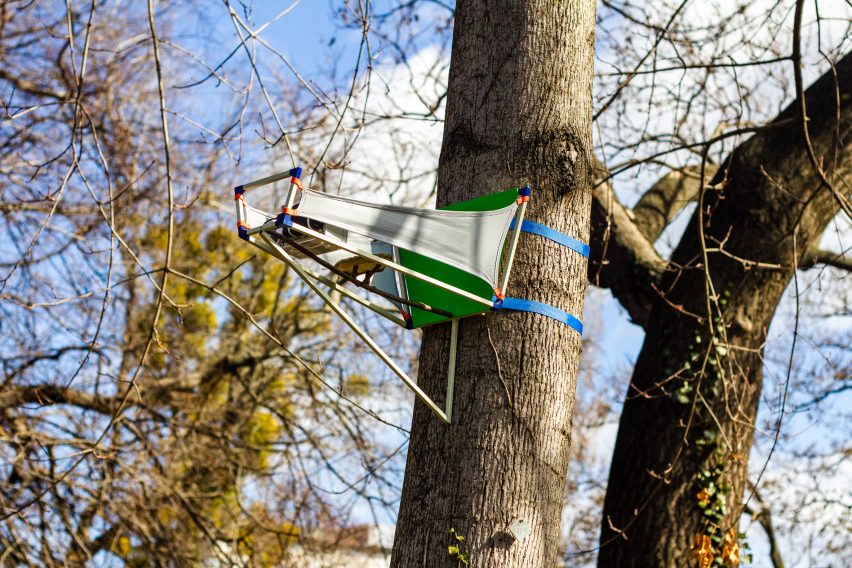
Interspecies Play by Takuma Kikuchi, Lucy Li, Florian Sapp and Alan Schiegl
"Can we have multispecies playgrounds in cities? Wild animals are adapting to environmental destruction by migrating to cities.
"Inspired by this fact, Interspecies Play explores the relationship between humans and urban wilds. The adventure begins with the idea of a multispecies playground – a public space for different species to have fun and interact with each other as much as they want to.
"With this in mind, we started the process of designing shared play objects, asking urban wilds for feedback. They were ruthlessly honest and shaped the fascinating outcomes of our design project."
Students: Takuma Kikuchi, Lucy Li, Florian Sapp and Alan Schiegl
Course: Design Investigations (Industrial Design 2)
Tutors: Anab Jain, Nikolas Heep, Peter Knobloch, Matthias Pfeffer and Stefan Zinell
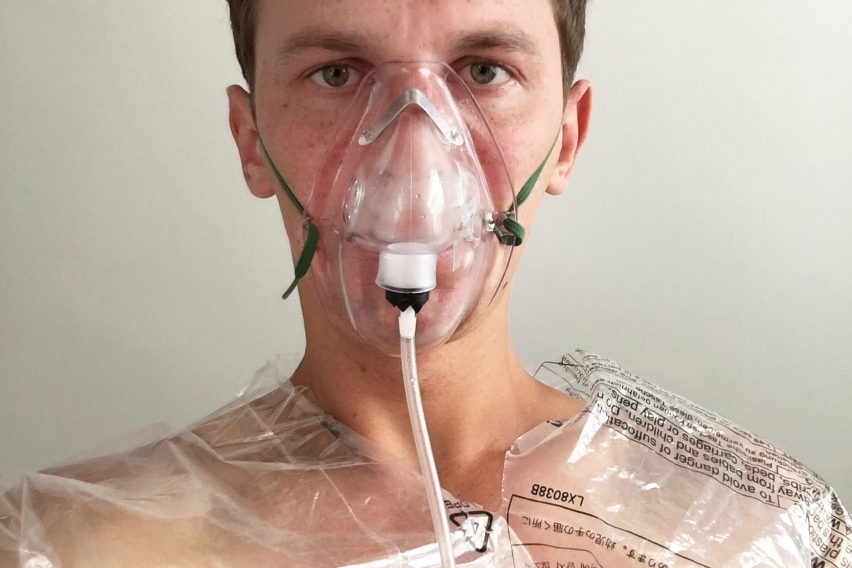
Counting Drops by Philipp Loidolt-Shen
"On average, a person in Austria uses 130 litres of water daily. Whilst we take the endless supply of water for granted, scientists warn that severe droughts, floods and unpredictable weather are likely to become more frequent.
"It is therefore critical that we learn to value water as the precious resource that it is. With Counting Drops, Loidolt-Shen set himself gruelling missions to cut his own water consumption from 130 litres to just 1.5 litres per day.
"To achieve this, he designed extreme hacks that challenged social and psychological norms, drawing attention to our current lifestyles of excess and abundance."
Student: Philipp Loidolt-Shen
Course: Design Investigations (Industrial Design 2)
Tutors: Anab Jain, Nikolas Heep, Peter Knobloch, Matthias Pfeffer and Stefan Zinell
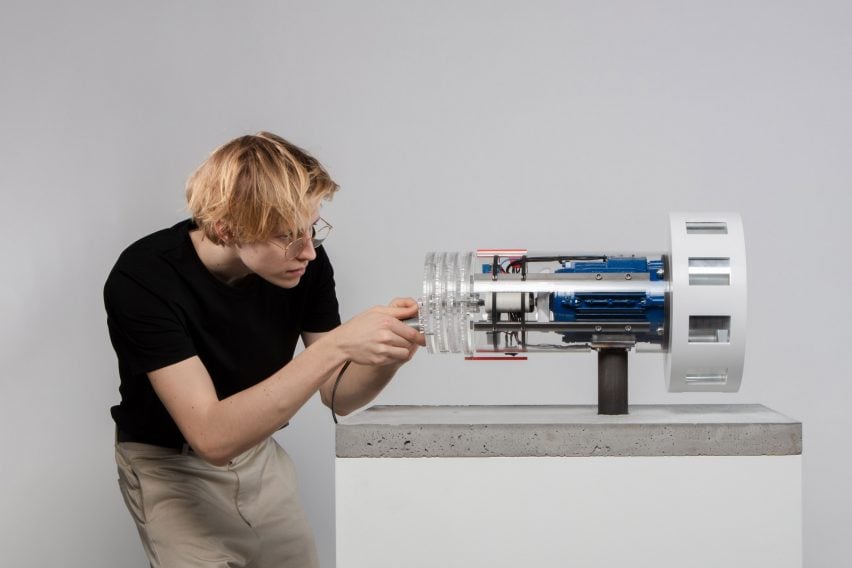
Political Atmosphere by Felix Lenz
"Political Atmosphere amplifies the invisible connections between flight turbulence, climate change and war. It features a live visualisation of the surrounding flight traffic and a custom-made, industrial-sized siren.
"The constant feed of open data received by an ADS-B antenna is paired with mechanical gears, picturing the slow, violent build-up of potential until it reaches tipping point.
"The gear-transmission adapts its speed in accordance with the current flight density and ultimately releases the siren. The howling roar of the siren, both literally and metaphorically, has become a reality in conflict-torn areas. At last, it is starting to echo back on western society."
Student: Felix Lenz
Course: Design Investigations (Industrial Design 2)
Tutors: Anab Jain, Nikolas Heep, Peter Knobloch, Matthias Pfeffer and Stefan Zinell
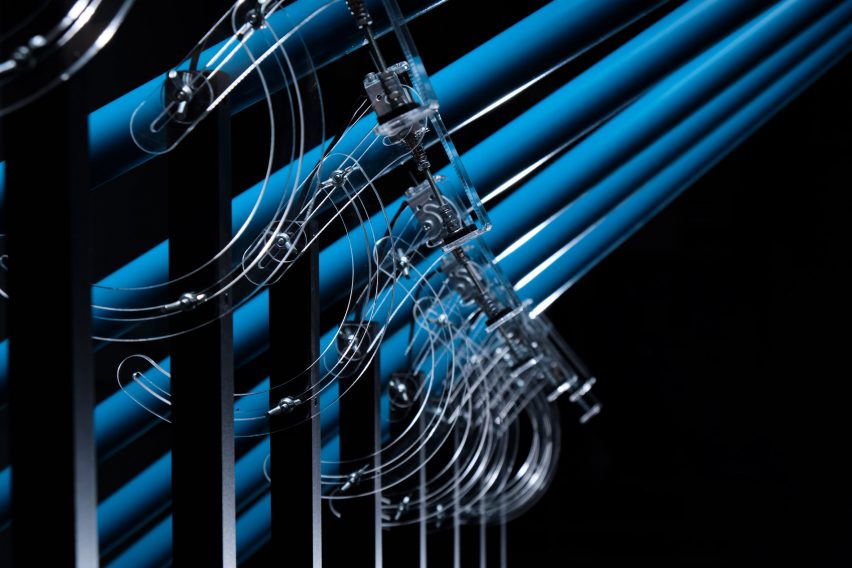
Offscreen Virtues by Florian Semlitsch
"Offscreen Virtues celebrates the absence of duty. It invites us to pause, to play, to be intrigued by single musical tones and to explore the poetic interplay of light and sound to create harmonic tunes.
"The instrument in the project has been designed to be used with phones. But, in order to play, we must turn our phones off. Eight light sensors await sunlight to be reflected off the surface of our phones, triggering signals that are transformed into analogue sound.
"And while we play a song or two, the installation invites us to reflect on the non-digital virtues of our phones."
Student: Florian Semlitsch
Course: Design Investigations (Industrial Design 2)
Tutors: Anab Jain, Nikolas Heep, Peter Knobloch, Matthias Pfeffer and Stefan Zinell
Am I Gaboniontum? By Emilie Dyrløv Madsen, Sophie Hausmann, Johannes Lotze and Florian Sapp
"What might life have been like for the Gabonionta 2.1 billion years ago? Captivating visualisations of the Gabonionta and their environment were created using speculative design methods based on the original fossils.
"Artificial intelligence (AI) provides a non-human perspective on evolution. Questions like 'what do the Gabonionta look like?', 'how do they communicate with each other?', 'how do the Gabonionta move around?' and 'how do they interact with their environment?' are answered in many variations.
"The text generated by the AI serves as a starting point for the visualisations of this fictional prehistoric world."
Students: Emilie Dyrløv Madsen, Sophie Hausmann, Johannes Lotze and Florian Sapp
Course: Design Investigations (Industrial Design 2)
Tutors: Anab Jain, Nikolas Heep, Peter Knobloch, Matthias Pfeffer and Stefan Zinell
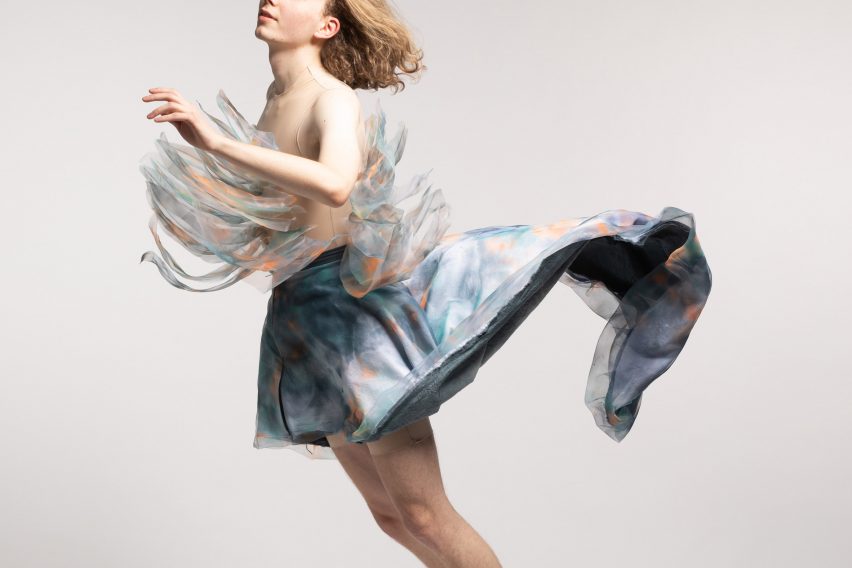
Shedding Skin by Anna Martić, Stefan Schönauer and Michalina Zadykowicz
"A free, flowing, delicate and fluctuating body evolves in a lifelong process of learning and healing. For the queer community in particular, embracing your identity and finding confidence in your body is a hugely empowering process.
"This handcrafted, wearable object shows the transition of the constricted body to one that is free and nonconforming.
"An internal metamorphosis that is displayed on the outside by a garment transforms itself from a constrictive, drab shell into a flowing gown.
"The dramatic change in colour, shape and appearance happens through a confident gesture; pulling actual weight off your chest."
Students: Anna Martić, Stefan Schönauer and Michalina Zadykowicz
Course: Design Investigations (Industrial Design 2)
Tutors: Anab Jain, Nikolas Heep, Peter Knobloch, Matthias Pfeffer and Stefan Zinell
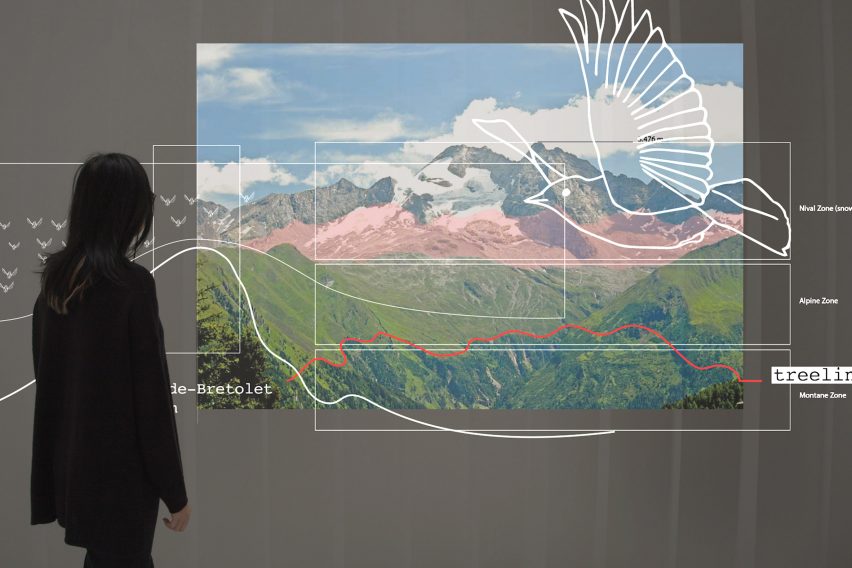
First Encounters by Sophie Falkeis
"What happens, if two species that have never interacted before must now encounter due to anthropocentrically changed climatic circumstances?
"The project 'First Encounters' tells the stories of species that meet for the very first time, due to climate induced range shifts. The installation visualises possible consequences that travel through local and global ecologies to various human-made systems, manifesting as real every day challenges for humans to overcome.
"The mission of the project is to make the consequences of our own actions a spatial experience, showing that we are just one species amongst many."
Student: Sophie Falkeis
Course: Design Investigations (Industrial Design 2)
Tutors: Anab Jain, Nikolas Heep, Peter Knobloch, Matthias Pfeffer and Stefan Zinell
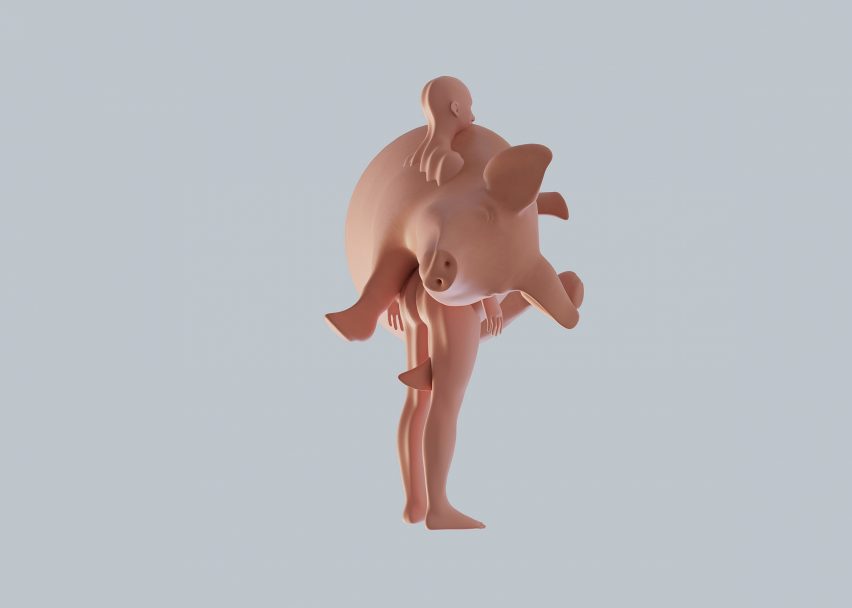
Multispecies Worlds Forager by Meda Retegan
"The Multispecies Worlds Forager is a fictional tool that invites us to contemplate possible futures from the perspective of other species.
"The prototype uses maps to show data from Europe of how human activities such as farming and tradition impact other species. The consequences of industrial farming extend far beyond humans, affecting entire ecosystems, showing how interdependent and complex natural systems are.
"The story focuses on pigs, who, separated from nature, have been altered for human consumption. What experiences of the world are we creating for them? What kind of pressures do we enforce on their bodies, environments and agency?"
Student: Meda Retegan
Course: Design Investigations (Industrial Design 2)
Tutors: Anab Jain, Nikolas Heep, Peter Knobloch, Matthias Pfeffer and Stefan Zinell
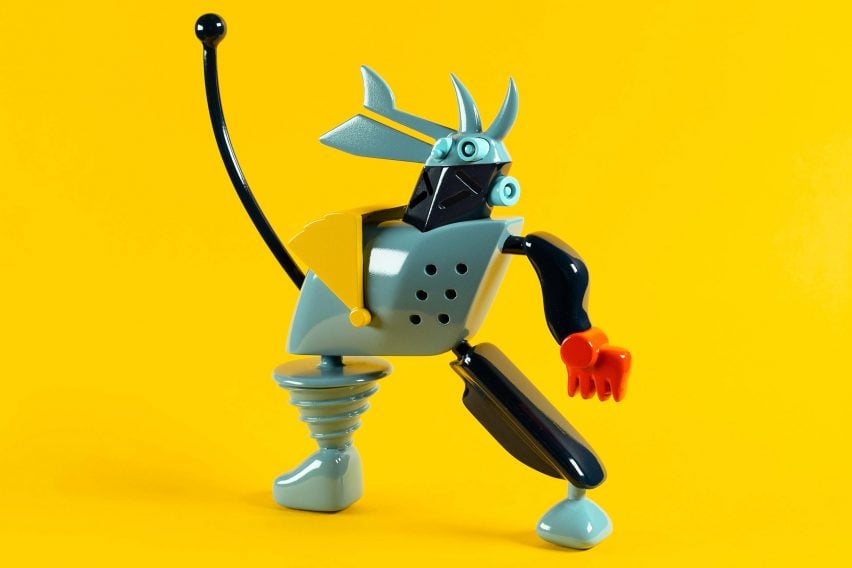
Centaur Design Experiment by Leo Mühlfeld
"The Centaur approach was theorised when Garry Kasparov lost a chess tournament to IBM's Deep Blue in 1997. Instead of feeling defeated, he saw this as an opportunity for an exciting form of chess to emerge – one in which machines and humans shared their best features.
"Inspired by this idea, the Centaur Design Experiment explores collective modes between humans and AI in a collaborative design context. The project developed an innovative process – tailored for children – where humans and artificial intelligence work together to design toys.
"A fully working prototype of this process was successfully designed and tested with school children."
Student: Leo Mühlfeld
Course: Design Investigations (Industrial Design 2)
Tutors: Anab Jain, Nikolas Heep, Peter Knobloch, Matthias Pfeffer and Stefan Zinell
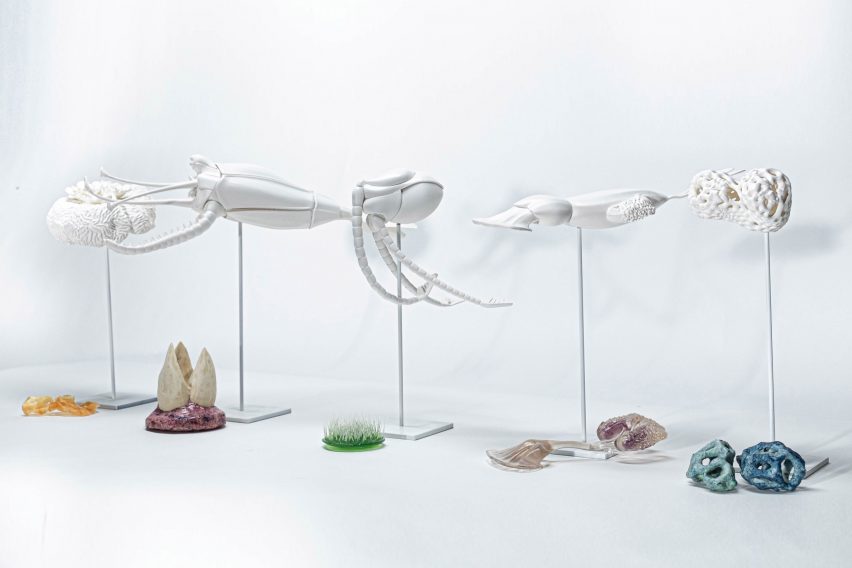
Humanless Nature by Moritz Berchtold, Eva-Maria Lainer, Stephan Sinn and Ludwig Rieger
"It is a challenge to imagine our Earth with entirely different ecosystems and organisms. What if a species responded to environmental changes with novel symbioses? The ecosystem in this diorama is a fictional response to this question.
"Mutualism is an interrelationship between living organisms of various species for mutual benefit. We let the Gabonionta evolve in a world characterised by mutualism, where there are no predators and the principle of 'survival of the fittest' does not hold.
"In this speculative world, competition and natural selection are not the primary driving forces of evolution."
Students: Moritz Berchtold, Eva-Maria Lainer, Stephan Sinn and Ludwig Rieger
Course: Design Investigations (Industrial Design 2)
Tutors: Anab Jain, Nikolas Heep, Peter Knobloch, Matthias Pfeffer and Stefan Zinell
Partnership content
This school show is a partnership between Dezeen and University of Applied Arts Vienna. Find out more about Dezeen partnership content here.